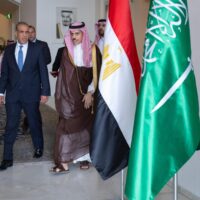CAIRO: At a field hospital in Tahrir Square Sunday morning protesters were ferried in, some unconscious and some bleeding.
At least 1,000 were taken to the makeshift hospital of the iconic square, said Doctor Mohamed El-Helaly.
“At least three died, one of which from rubber bullets,” El-Helaly said.
The Ministry of Health said over 700 were injured and two died on Saturday. By Sunday evening, the ministry couldn’t confirm a total number of the injured as the clashes between protester and police entered their second day.
Field doctors said the injuries increased dramatically as the military joined central security forces in clearing the square from protesters on Sunday evening.
Other medical sources said three died on Sunday.
According to physicians in the square at various makeshift hospitals, all cases that arrived were suffocated by teargas, injured in the arm or eyes by rubber bullets. Several cases were reported of complete eye damage as a result of pellet shots and rubber bullets.
None of the physicians interviewed said they treated or heard of wounds resulting from live ammunition.
As El-Helaly explained the situation in Tahrir, three men carried one unconscious 14-year-old boy. The men placed the boy on the ground and Helaly ran towards him.
After a number of attempts, the boy finally regained consciousness and was given food and something to drink.
All protesters inside the hospital displayed reddened eyes, one of the symptoms of the teargas, which filled the air outside as the police kept firing the canisters at the protesters on Mohamed Mahmoud Street.
Ambulances provided by the health ministry helped treat the injured on site. Protesters exchanged advice through online social networks on how to combat what they described as more potent teargas.
Medical supplies needed in Tahrir were repeatedly announced online.
Meanwhile, the Al-Monira Public Hospital was the destination of injured CSF soldiers. Most of the soldiers there were suffering from teargas inhalation. Although they fire canisters at protesters, soldiers are not provided with masks to protect them against suffocation.
The under-equipped emergency room of the hospital also tended to other injuries, mainly the result of rocks thrown by protesters.
On Sunday noon, a soldier who refused to give his name was waiting for the doctor to tell him the reason causing the pain in his arm. His arm was fractured and he was advised to go home, but instead he headed back to his unit.
“Since yesterday most of those we had received were security forces soldiers, but we also receive protesters. A man who is now in undergoing surgery had pellets in his stomach and head,” said doctor Sonya Abdel Fattah.
The hospital also catered to injured bystanders, amongst them 12-year-old Mostafa Awad.
Awad was walking out of his school when he was hit by a teargas canister that cut through his skin into his stomach.
Once spotted in the hospital, a number of the nurses began to scream in shock at the boy’s condition. By the afternoon, his family hadn’t been informed.
Doctor Mohamed Shawky, the hospital’s general manager, said that of about 91 cases transferred to the hospital, one died.
Not far from Tahrir, Qasr El-Eini Hospital was also receiving the injured.
Its administration confirmed that none of their patients died. Injuries included rubber bullets in the stomach, back and eyes.



